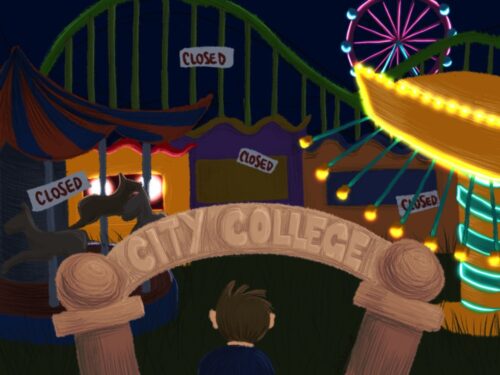Drastic cuts across the board to address College’s “dire fiscal emergency” in approved Multi-Year Budget and Enrollment Plan
By Annette Mullaney
Special to The Guardsman
Substantial cuts are on the horizon to address City College’s “dire fiscal emergency” in the Multi-Year Budget and Enrollment (MYBE) Plan adopted unanimously by the Board of Supervisors Nov. 12 despite vocal opposition.
“City College is faced with an existential crisis,” said Administrators Association Co-Chair Jill Yee at the board meeting. “We must set a sustainable course which reflects the realities of declining enrollment and decreasing revenues.”
That declining enrollment, plus years of deficit spending, depleted reserves, and delayed state funding because of the pandemic have put the college in danger of becoming insolvent, threatening its accreditation. In September, the Accrediting Commission for Community and Junior Colleges (ACCJC) placed City College under enhanced monitoring, requiring a response by early December.
In addition, the College faces a financial cliff in 2024-25, when it is projected to lose $8 million in state funding. Currently, City College receives State funding regardless of enrollment due to a “hold harmless” measure intended to help community colleges transition to the new formula based on enrollment and certain success measures.
The MYBE, which sets out revenue expectations and spending guidelines through 2024-25, will reduce spending on personnel across all categories. Part-time faculty will be particularly hard hit: using 2020-21 as a baseline, there will be a 27% decrease in spending from unrestricted funds in 2021-22, and 44.3% by 2024-25. Overall spending on faculty salaries will fall by 15% in 2021-22 and 23.9% by 2024-45. The plan also targets cutting at least 600 class sections in 2021-22, a decrease of 11%.
Many faculty opposed the cuts, saying the plan did not provide specifics or priorities guiding cuts. “Instead of actually figuring it out and coming up with an analysis and a plan, we just keep cutting,” said Enrollment Management Committee Co-Chair Wynd Kaufman, adding “There’s no analysis of where these cuts would be.”
“Robust full classes are being cut with these sort of top-down slash and burn cuts,” said English as a Second Language (ESL) teacher Alison Datz, one of many ESL teachers and students, as well as Ethnic Studies instructors, who spoke in opposition to the plan, believing that cuts to part-time faculty will affect their programs disproportionately. Vice-Chancellor of Academic Affairs Tom Boegel did confirm at a Nov. 5 Participatory Governance Council meeting that the majority of those 600 section reductions will come from cutting part-time instructors.

Many faculty pointed to what they called disproportionate cuts to faculty, particularly compared to administrators. “Isn’t the purpose of a college to provide classes for students?” said Rick Baum, member of Higher Education Action Heat (HEAT) and part-time professor. “It’s not the administrators who teach them.”
Administrators and classified (i.e. service and support) staff spending will also be cut about 11% in 2021-22 and 17% by 2024-25, with 2020-21 as a baseline. However, 2020-21 budgets themselves reflect previous cuts to classes and faculty, including the elimination of 250 part-time faculty this summer, and the cut to 300 course sections last year.
Datz said the College has been in a “downward spiral” of cutting classes and concomitant enrollment declines, predicting these cuts would only exacerbate the decline.
City College’s enrollment declined precipitously in the past decade, outpacing the general downward trend for community colleges in California and the Bay Area. While statewide enrollment declined 18.6% since 2008-09, City College’s decreased by 34.6%. The pandemic hasn’t helped; enrollment for Fall 2020 is down 18% from last year.
According to Academic Senate President Simon Hanson, part of this spiral is due to the “hold harmless” funding formula, which disconnected state revenues from enrollment. “There’s no incentive to get more students,” he said. “[Hold harmless] allowed for cutting. Before, we had to adjust.”
The MYBE aims to stabilize enrollment despite cuts, though does not outline how. Chancellor Rajen Vurdien did say at the meeting that current classes have a fill rate of 70%, so even with cuts “there will be enough sections so that not a single one of the courses that we offer on a regular basis will be eliminated.”
Many faculty were disappointed that previous goals to increase enrollment have been abandoned. “Do we imagine that enrollment can’t increase?” said American Federation of Teachers 2121 President Malaika Finkelstein. “Maybe it’s a hammer to hold over our heads as we go into contract negotiations.”
“There’s an assumption that these students are gone and that we can’t attract new students… I think that’s a false assumption” said Teacher Preparation Coordinator Kathleen White. “We’re going to have to be positively innovative, self-reflective, set realistic goals, market to our community, and not make changes every year in the schedule and registration process.”
“We had two years of overspending to try to grow enrollment and it didn’t happen,” said Senior Vice Chancellor of Administrative and Student Affairs Dianna Gonzales.
Student Trustee Vick Van Chung is still hopeful about growing enrollment. “How can we capitalize on the fact that we’re in one of the wealthiest cities in the world?” she said. In lieu of budgetary support,“we’re going to have to get creative. We’re going to have to pull some serious grassroots organizing.”
